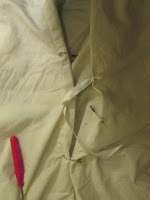Last week, I installed the last of the replacement heads I had stored up for our Fuchs Ecotek toothbrushes. I'd known this day was coming for about a year, ever since I went looking for information about where to buy the Ecotek and discovered that it was no longer available. And I'd found two possible alternatives to replace it: the Greener Step Snap toothbrush, a similar plastic replaceable-head model, and the various brands of bamboo-handled toothbrushes available online. But I hadn't been sure which was the more ecofrugal alternative. The bamboo brushes were definitely cheaper, even with shipping costs, but which was greener? Was it better to discard an entire toothbrush made primarily of bamboo (but with non-compostable nylon bristles) every three months, or just the head of a plastic toothbrush? As I wondered in my original blog entry on the topic, "How do you even compare the two?"
Well, as it turns out, a team of British and Irish researchers with a lot more resources than I have to devote to the subject have figured out how. They did a complete lifecycle analysis of four different kinds of toothbrushes — electric, single-use plastic, replaceable-head plastic, and single-use bamboo — and compared their "Disability-Adjusted Life Years," or DALYs. That's the number of years (or in this case, hours) of life that each toothbrush would cost a human population in illness, disability, and death. This factors in all forms of pollution, including greenhouse gases, as well as costs such as water use, to figure out exactly which kind is the most sustainable overall. (If you don't want to read the whole study, you can read a summary here.)
The upshot is, measured in DALYs, the reusable-head toothbrush is definitively better than the bamboo one. It does have a larger carbon footprint, but only by a tiny bit, and its water footprint is significantly lower. However, both of them are much better than a single-use plastic toothbrush, as it's the plastic handle that has the biggest ecological footprint. And they are both an order of magnitude better than an electric toothbrush on pretty much every measurable dimension. (Of course, you could argue that an electric toothbrush has human health benefits not measured by this study, based on this study that shows it does a better job of preventing cavities. But dentists interviewed by Consumer Reports say the type of brush you use matters far less than your brushing technique and how often you replace it.)
Now, I should point out that just because a reusable-head toothbrush is the most sustainable of all existing options doesn't mean it's the best of all possible toothbrushes. The researchers also evaluated alternatives possible alternatives like:
- A single-use bioplastic toothbrush. This was not better than a single-use plastic handle, because it reduced the carbon footprint only slightly and increased DALYs significantly.
- Toothbrushes packaged in large cardboard boxes rather than individual blister packs. This is an improvement over the single-use plastic brushes we have now, but it doesn't reduce carbon footprint significantly.
- A toothbrush with a reusable handle made of aluminum rather than plastic. This significantly reduces both DALYs and carbon footprint, but not by as much as...
- A recycling scheme that allows both plastic toothbrushes and their packaging to be returned to the manufacturer and recycled, with new toothbrushes being made of 90% recycled plastic.
This hypothetical recycled toothbrush could reduce both carbon footprint and DALYs by a considerable margin. However, nothing like it currently exists. I've actually discovered a Mexican company that seems to be working on it, but their product, the Everloop toothbrush, doesn't appear to be available yet. So for now, at least, the plastic reusable-head toothbrush is the best we can do.
Which is why Brian and I are now the proud owners of a pair of Greener Step toothbrushes. I chose the "Value 12 pack" with two handles (we choose green and orange, though you can also go for red and blue) and a dozen snap-in heads. That cost us $19.95 (including shipping), for cost of $1.66 per brush. Brian's, the orange one, has already been deployed in our DIY hacked toothbrush holder; I'm sticking with my old Ecotek for now, since it has this brand-new head that it would be a shame to waste. But once that wears out, I'll switch to the green toothbrush, and probably change the head in Brian's at around the same time. Assuming we continue replacing the heads every three months, these should last us about a year and a half.And if, for some reason, the Greener Step is no longer available at that point, I'll know I can simply order a pack of bamboo-handled toothbrushes that are almost as good, rather than having to go an another deep dive looking for a new sustainable option. (Or, who knows — maybe the Everloop will be on the market by then, and I can give that a try.)












